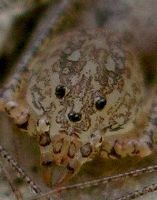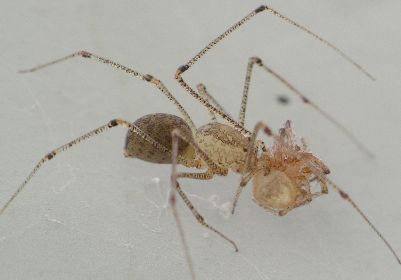
| Scytodidae ~ Spitting Spiders |
|
The spitting spiders are so named because they really do spit venom at their prey, up to several cm away. I've poked and prodded various individuals and they have never spit under those conditions, so this is really just a hunting aid and not a defense mechanism. The most unique feature of this family is the dome-shaped cephalothorax, sometimes looking about as large as the abdomen, almost completely filled with a pair of glands that produces the sticky substance that immobilizes prey. There is a second pair of glands that is smaller and has regular poison. Because their "head" is filled with liquid, it appears translucent when backlit.
There may be more than one species in our area but they are all in the genus Scytodes. These spiders are usually found under rocks or in corners of buildings such as greenhouses, sheds and garages. They are never very numerous but are not rare either. Body length is about 7-8 mm and the legs are very long and spindly. Spitting spiders are slow moving and will usually try to curl up and hide if threatened. I've found single individuals under rocks with no web at all, females with eggs hiding within a loosely constructed retreat, and several individuals at a time in well-protected large and messy webs, not unlike those of cellar spiders. One of the main differences between various families of spiders is the number and arrangement of the eyes. Quite often, this is not the easiest thing to see without magnification so it is of limited use in field identification. The six (as opposed to the more common eight of many other families) eyes of the spitting spider, though, are very readily observed. They occur in three closely spaced pairs, and the arrangement looks like the cute button eyes and nose of some toy or snowman. They eyes are black and each pair blends together to look like just one spot.
Females do not make much of a sac for their eggs, but do bind them together into a ball which they carry around in their chelicerae (fangs). Males and females are similar in size and may live in the same web. Spitting spiders may be confused with cellar spiders or pirate spiders which also both have light-colored bodies mottled with spots and long legs. The former, though, is almost always found in a web and the latter is usually found on vegetation, hiding under rocks only in the winter. The main difference, though, is that unique bulging cephalothorax. |
![]()



